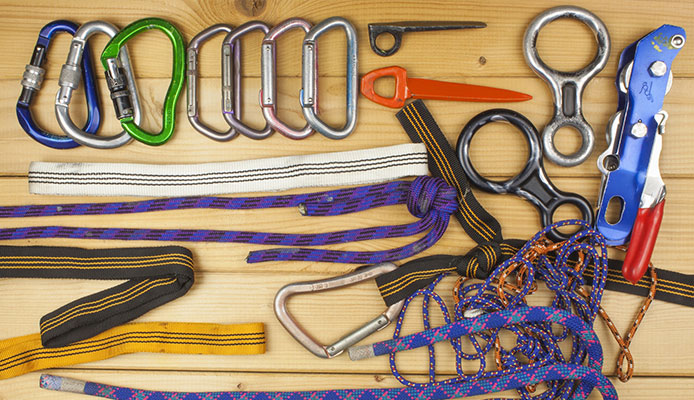How to Tie a Friction Knot

When climbing outdoors, many situations can easily arise. For example, you may need to clean your climbing anchor or rappel down because a storm is approaching and your fixed hardware is too sharp to be lowered down.
For these instances and others, you should carry a short-length cord and a locking carabiner to make a friction hitch. Simple and easy to make, a friction knot can get you out of many sticky situations. In the following sections, we will take you through the process of tieing various friction knots.
How to Make a Friction Hitch – Step by Step Guide
Below, we have presented each of the 3 friction hitches in their ascending order, starting from light friction to maximum friction. We have also outlined their common usages and their pros and cons.
Autoblock Friction Knot
This knot features the least friction. It is generally used to back up the brake hard during rappels. To assemble this hitch, you will need to follow the steps below:
- Clip a small locking carabiner to the belay loop. Next, clip one end of the looped cord into the carabiner.
- Wrap the cord around the climbing rope 3 to 4 times – depending on the diameter of the rope and cord – or as many times as necessary for the cord to bite down.
- Clip the other end of your cord back into the same locking carabiner.
The Pros
- It is quick to set up.
- The hitch is releasable under load.
The Cons:
- The hitch features the least amount of holding power.
The Klemheist Friction Hitch
This knot is usually used when the climbing needs more holding power than offered by the autoblock but less than a prusik knot. It is perfect for creating a mechanical advantage for the haul systems. Some rock climbers use the hitch for rope grab when ascending a rope while others use it when rappelling with extra weight, for example, a climbing backpack or an injured partner.
With the steps outlined below, assembling the Klemheist hitch should be easy for you:
- Take a joining knot or a bartack and scooch it to one end.
- With the other end, initiate wrapping the material around your rope strand in the load's direction.
- Wrap the cord around your rope 3 to 4 times and then pass the long end through the short-end loop. Be sure to pass it above the wraps.
- Clip a small locking carabiner to your long end and then pull. The tail of your loop should fold over the wraps. Squeeze them together.
The Pros:
- It features more holding power than the autoblock.
- It works perfectly with webbing or cord like the nylon sling.
The Cons:
- The hitch only works in one direction.
- Since it is directional, you have to pay close attention to which tail you fold over. If you make a mistake, it may work but the possibility of slipping under load will be high.
Three-Wrap Prusik Hitch Knot
This friction hitch is perfect for when you need maximum holding power, like in self-rescue applications and rope grabs in haul systems. One of the main benefits of the prusik is that it is multi-directional – this means that it allows you to move up and down the rope.
The downside of using the hitch is that it is impossible to release it under load. This makes it less ideal for rappel backup. The knot also takes more time to tie than the hitches describe above and it has to be dressed perfectly to make sure that it does not bind up.
To assemble this hitch, you will need to follow the steps below:
- Place the knot or bartack on your rope and then with the opposite end, start looping the cord carefully around the rope and back through the cord's center 3 times. Make sure that each wrap lies flat and nice and the coils are parallel to each other.
- Clip a locking carabiner to the loop emerging from the middle of your wraps. Start pulling.
- Make sure that the knotted end is farthest from your wraps, but it should not interfere with your locking carabiner.
The Pros:
- It is multi-directional.
- It has the highest holding power.
The Cons
- It is not great for rappelling since it is not releasable under load.
Globo Surf Overview
If you do use your climbing shorts regularly, you must understand how to tie a friction hitch. Making it extremely easy for you to get out of tricky situations and also making your climbing systems more secure, friction knots are classified as some of the best tools for rock climbers. By following the instructions in this article, you should be able to tie the 3 top-rated friction hitches.
More Climb Reviews:
- Climbing Helmet
- Belay Device
- Mountaineering Boots
- Crack Climbing Shoes
- Haul Bag
- Finger Pulley Injury
- Break In Climbing Shoes
- Rock Climbing Games
- Double Overhand Knot
- Rock Climbing Benefits
Source: https://www.globosurfer.com/friction-hitch/
0 Response to "How to Tie a Friction Knot"
Post a Comment